Day 1 of a three day Summer Tour. We could have chosen a better weekend, as it wasn’t going to be like summer on this one. The weather would be the problem – wet and “unseasonably windy” to quote the Met Office – and although the forecast would prove to be unduly pessimistic as ever, it was unfortunately not wrong enough! Today, the rain and wind wasn’t forecast to arrive until mid morning, so we had to make the most of this morning.
As we drove out of the village, we noticed a Grey Partridge on the verge. A nice start to the day and a scarce bird in intensive arable farmland like it is round here.
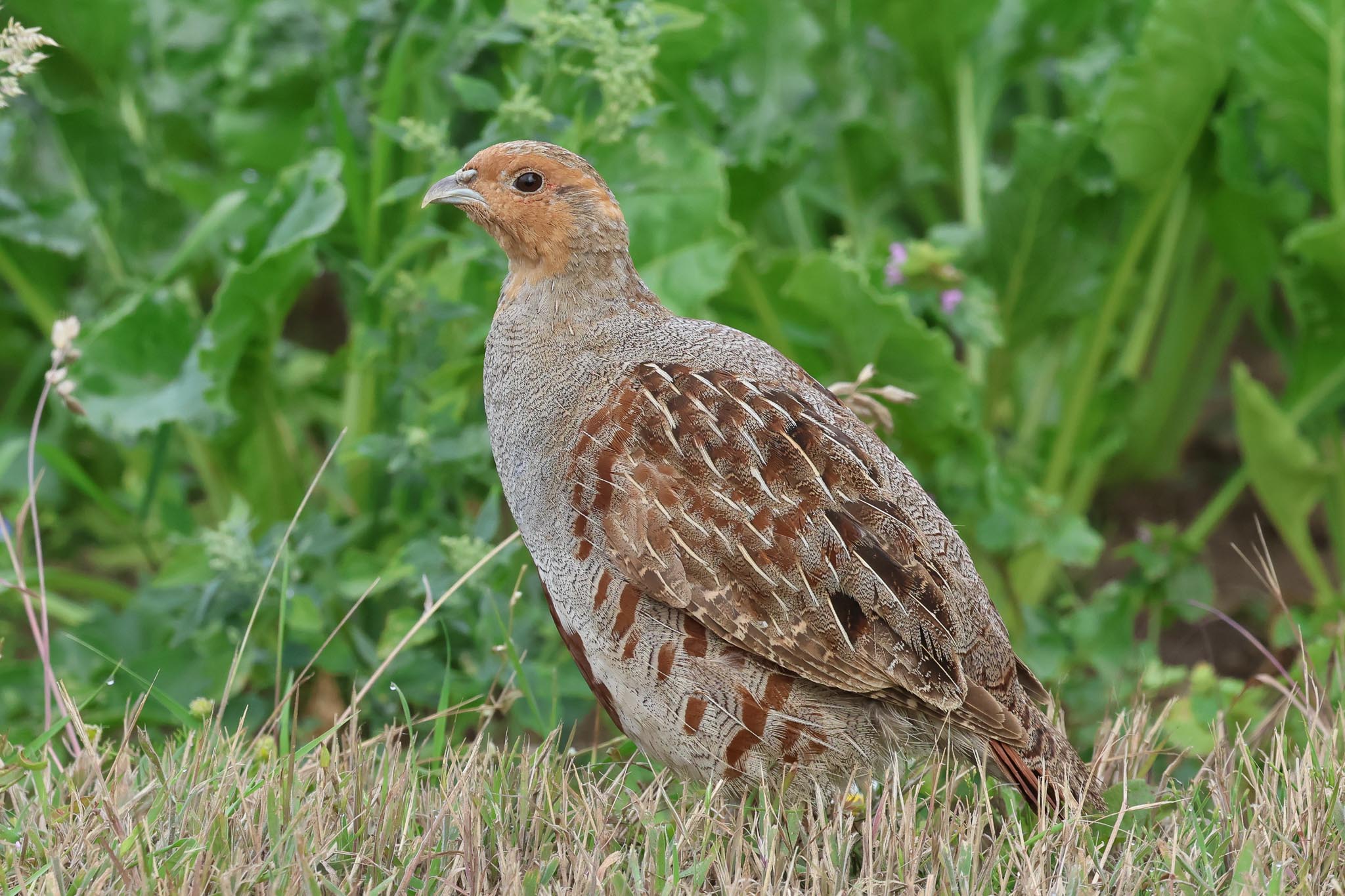
We headed down to Trimingham to see the Bee-eaters first this morning. Their first breeding attempt failed, and while they are showing every sign of having another go, there are no guarantees they will go through with it. Thankfully when we arrived in the car park, we could see them still on the wires behind the quarry with a load of Woodpigeons.
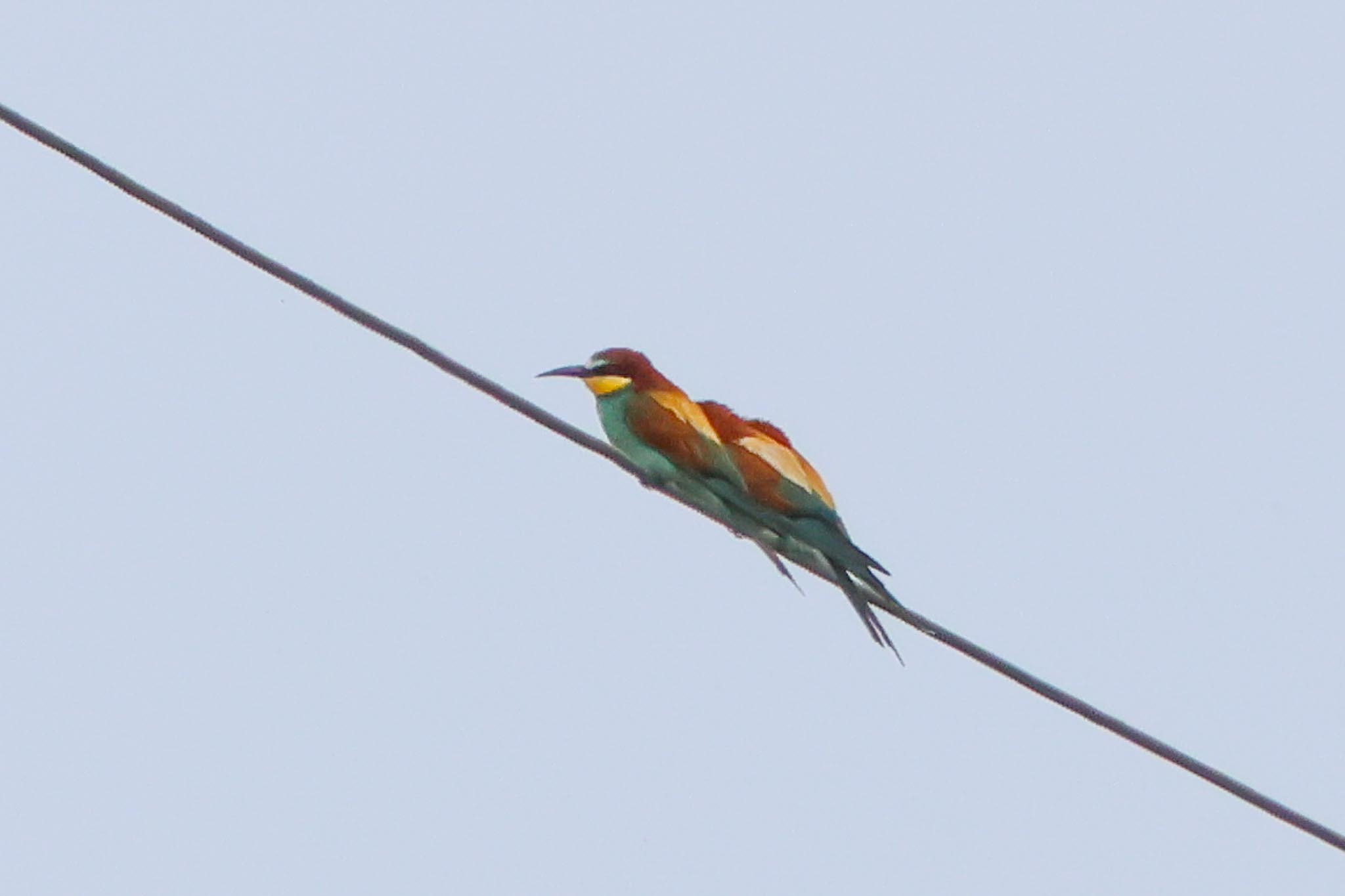
We walked down to the viewing spot and set up the scopes, getting a nice view of the Bee-eaters where they were still perched. They flew out from time to time, catching mostly bees and landing again, beating them on the wires to remove the sting. After a while, they flew down into the quarry calling and landed on the brambles, then down to the sandy face where they started to excavate. They have been in and out of the original burrow since their first breeding attempt failed but as we watched the male initially spent some time working on a new hole, before flying round and investigating an old one and then picking for a while in a completely new spot. It didn’t seem to have decided where to focus on, so perhaps a new breeding attempt is not imminent.
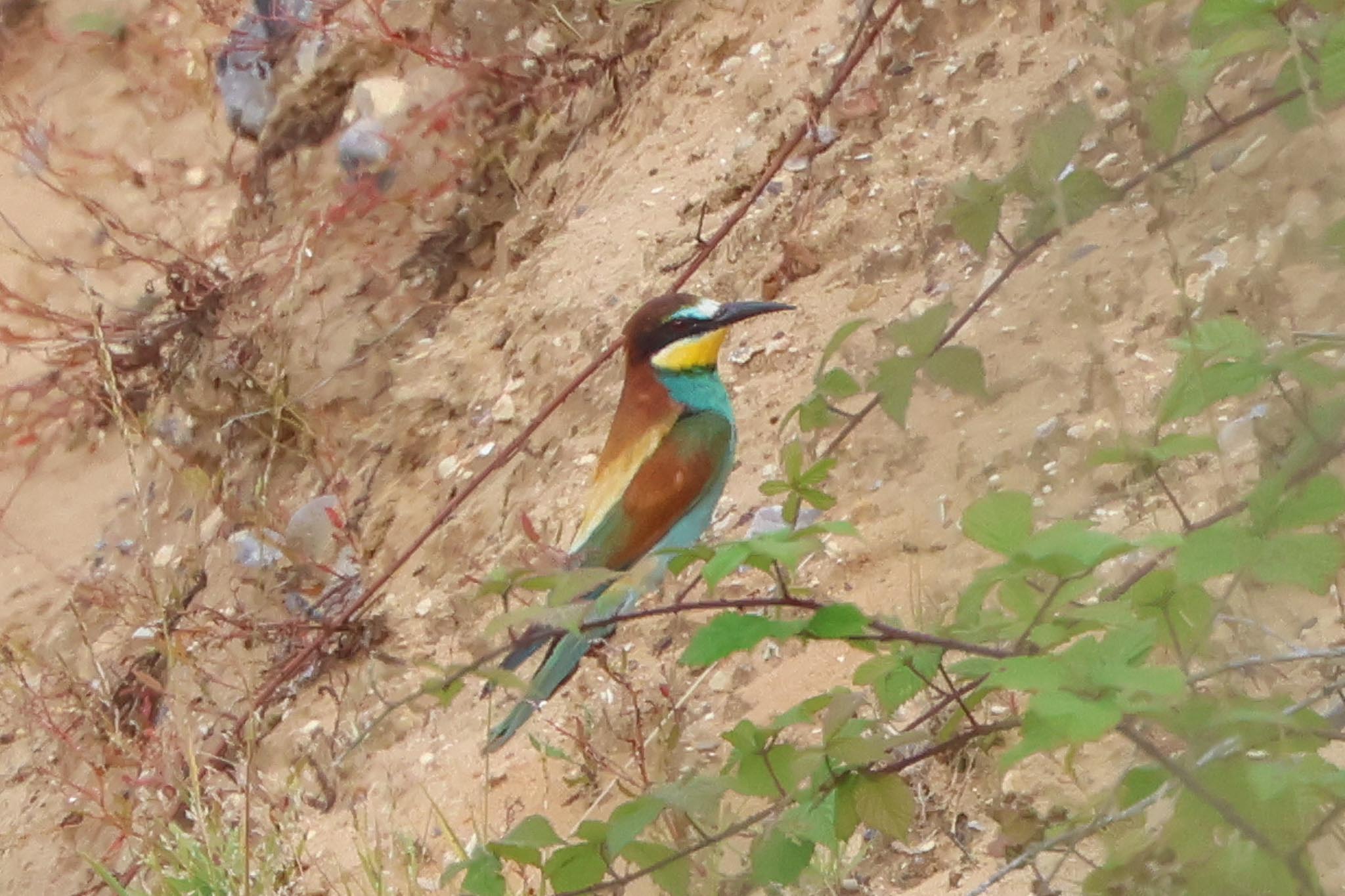
There were a few Goldfinches and Linnets around the quarry too, and a family of Magpies. When the Bee-eaters started calling and flew up, we looked up to see a Hobby flying fast over the quarry, before disappearing off towards the coast. The Bee-eaters quickly settled back down to work. A Kestrel was hovering behind the quarry too.
Having enjoyed some good views of the Bee-eaters, we decided to move on and make the most of the weather. We drove back along the coast to Salthouse, and it was already starting to spit with very light rain by the time we arrived. We parked by the Iron Road, and walked down to check out the pool, which is starting to dry out but that is producing some very nice wet mud at the moment. As we walked out, a small cloud of Sand Martins and Swallows flew up from where they were feeding around the cows.
It was a very productive stop – there were three Common Sandpipers in the top corner and a Wood Sandpiper feeding along the north edge. A Greenshank was next to a Redshank nearby, a nice comparison of the two species, and at one point they were together with the Wood Sandpiper. A Common Snipe appeared from the low reeds at the back of the pool next to them and four Dunlin were feeding in the middle, still sporting their black summer bellies. It may still seem like early summer to us, but most of these (with the exception of the Redshank) are returning migrants, heading back south for the winter, their breeding attempts possibly in Scandinavia already over, maybe having failed.
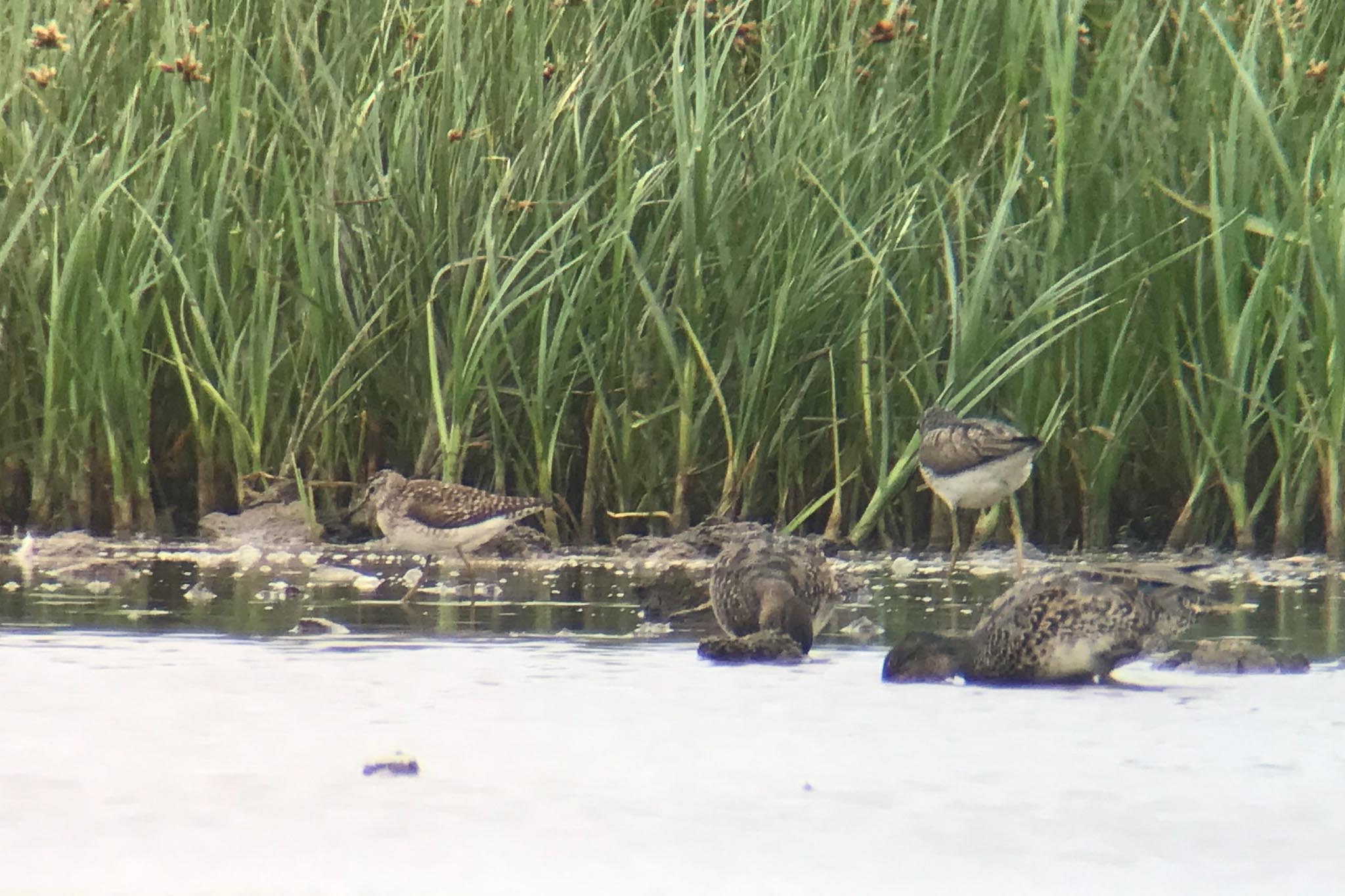
There were a few of our breeding waders on here too – a pair of Avocets had two tiny fluffy juveniles over towards the back, and were keeping the other birds away. There were a couple of Lapwing in the grass behind the pool and three Ringed Plovers and two fully grown juvenile Little Ringed Plovers on the mud in the middle.
As we walked back, a young Sedge Warbler, still with a partly grown tail, was lurking in one of the small sallows next to the path, and from time to time its parent would fly in to feed it. We stopped to watch and there were more young Sedge Warblers in the vegetation behind and a Reed Warbler flew up into the same sallow and hopped around, checking the leaves for caterpillars. We could see the bold pale supercilium on the Sedge Warblers, compared to the much plainer Reed Warbler. One of the group spotted a rather bare looking ragwort plant next to us which had been almost completely stripped by the bright yellow and black Cinnabar Moth caterpillars.
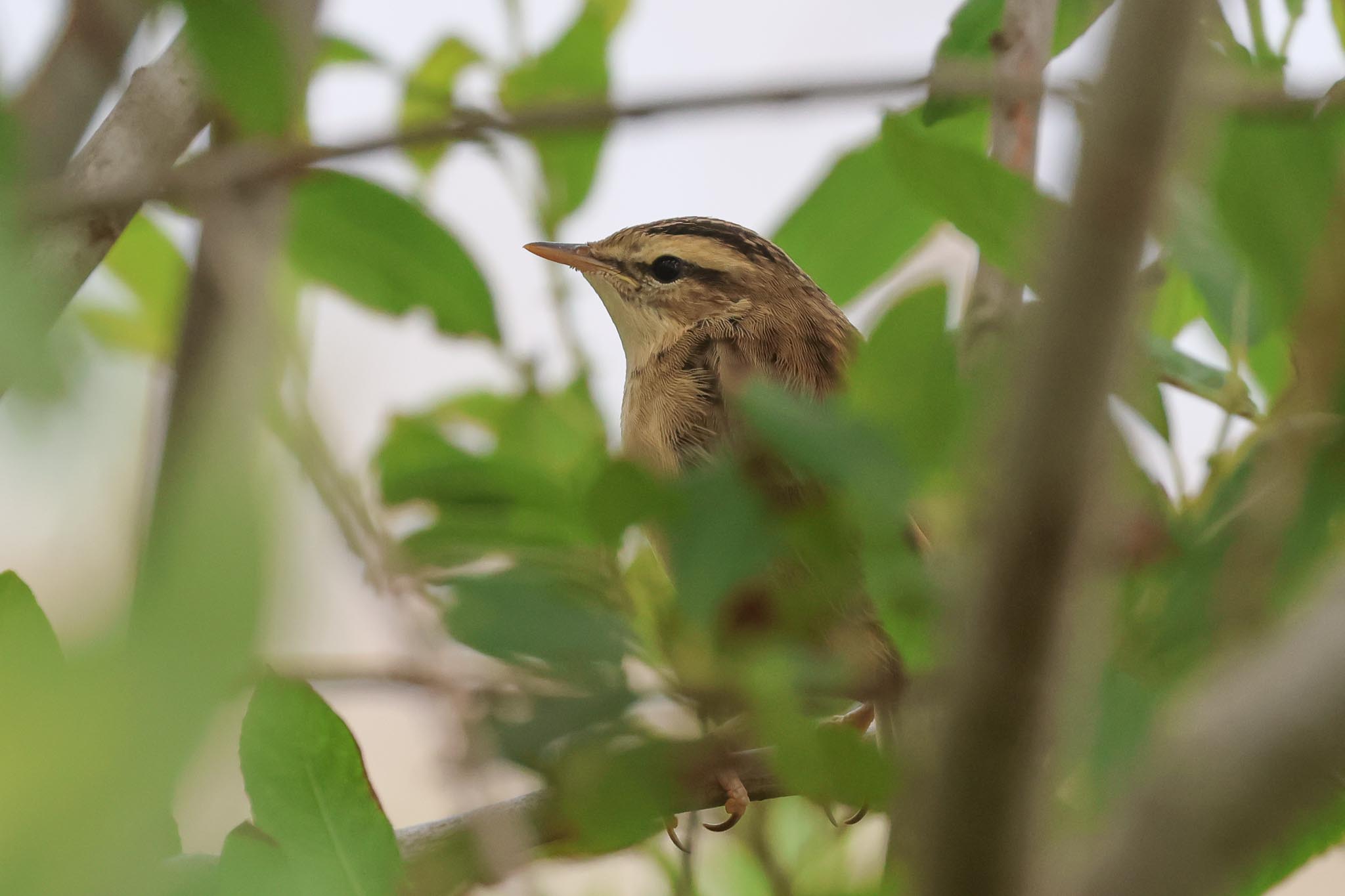
It was still only spitting with light rain on and off, so we drove towards Cley and stopped again at Walsey Hills. Snipe’s Marsh is starting to dry up too, at least ahead of any rain, so we stopped to scan the mud at the back. There were three juvenile Water Rails, still rather brown and not yet with fully grown bills, feeding on the edge of the reeds. Two Green Sandpipers were remarkably hard to see at first, stationary with their backs to us, coloured very like the greeny-brown mud and water, but one did than start to feed on the mud where we could see it better. More returning migrants.
We decided to have a go and see how far we could get up the East Bank, before the rain set in. A Little Grebe swam across Don’s Pool and our first Spoonbill of the day flew over the grazing marshes, the southernmost of which are already quite dry, and disappeared into one of the deeper ditches in the middle. A Reed Warbler was feeding in the tall vegetation along the bank and kept flying ahead of us as we walked on.
We could hear Bearded Tits calling and stopped to scan. After a while, three tawny juveniles climbed up the reeds on the other side if the ditch, perching in the tops for a few seconds before flying off back over the reedbed. We heard several more as we walked along, mostly juveniles but a female flew across the path in front of us at one point. Another juvenile perched in the top of the reeds for a while, looking round. We needed to make the most of the opportunity today – with the forecast wind this weekend, they will be harder to see in the coming days!
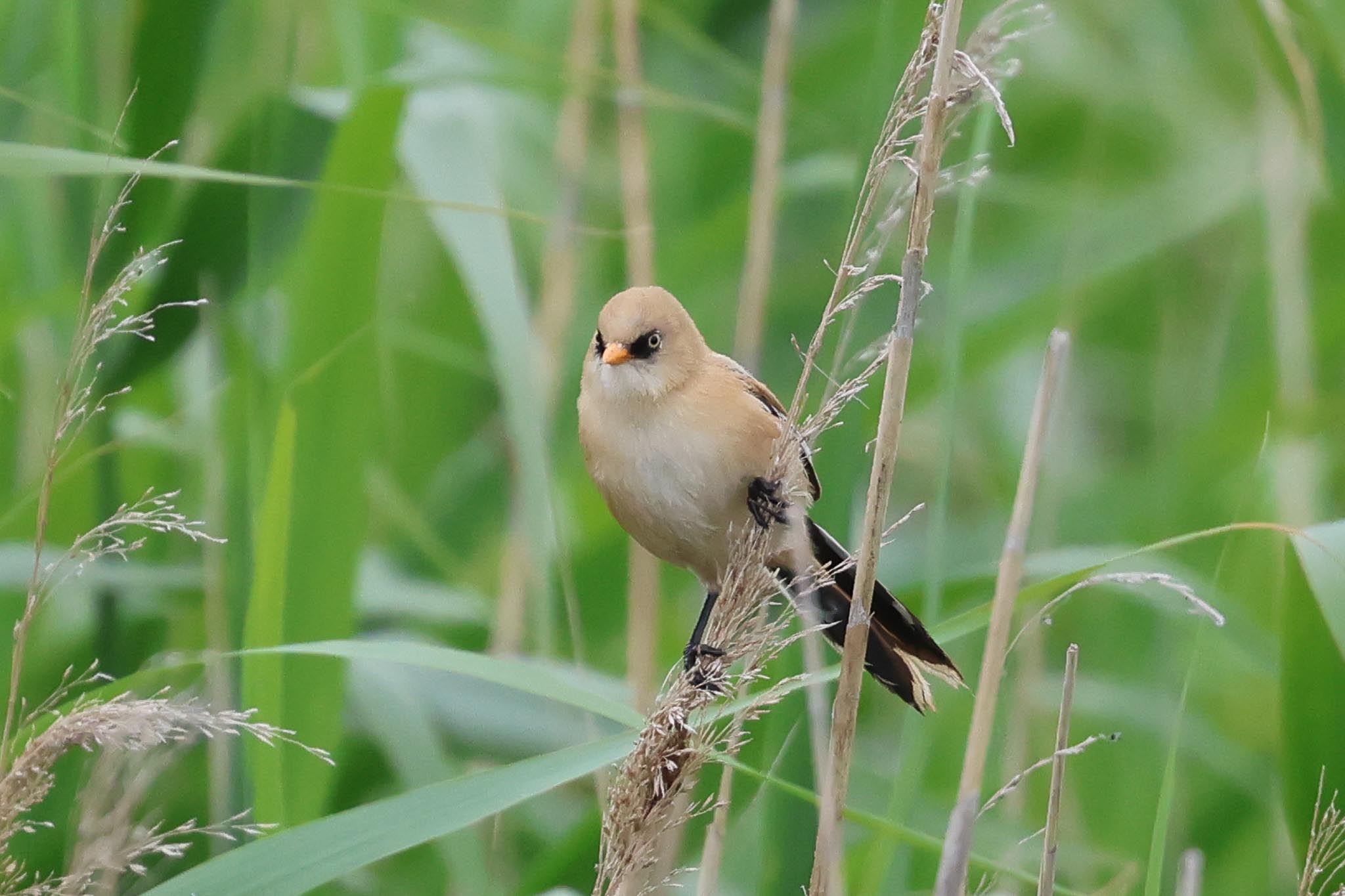
The Spoonbill eventually appeared out of the ditch and stood for a while on the bank. We got it in the scope so we could see the yellow tip to its long black bill, before it took off and flew back to the plantation across the road. Scanning the fields beyond, we picked up a Marsh Harrier hunting and a Common Buzzard perched on a telegraph post in the distance.
There is still water in the Serpentine, but not many waders on here today. There were more on Pope’s Pool further back, quite a few Black-tailed Godwits, some fresh returning birds still in bright rusty breeding plumage, and several Ruff in various states of moult. Another Greenshank was asleep in the middle. A small flock of Curlew flew in from the direction of Arnold’s Marsh and landed in the grass in front of the pool.
A Little Gull appeared from behind one of the islands, walking around in the shallow water, picking for insects, a 1st summer, lacking the black hood of a summer adult. A couple of times, it walked into the same view as a Black-headed Gull, at which point we could appreciate just how little the Little Gull really was.
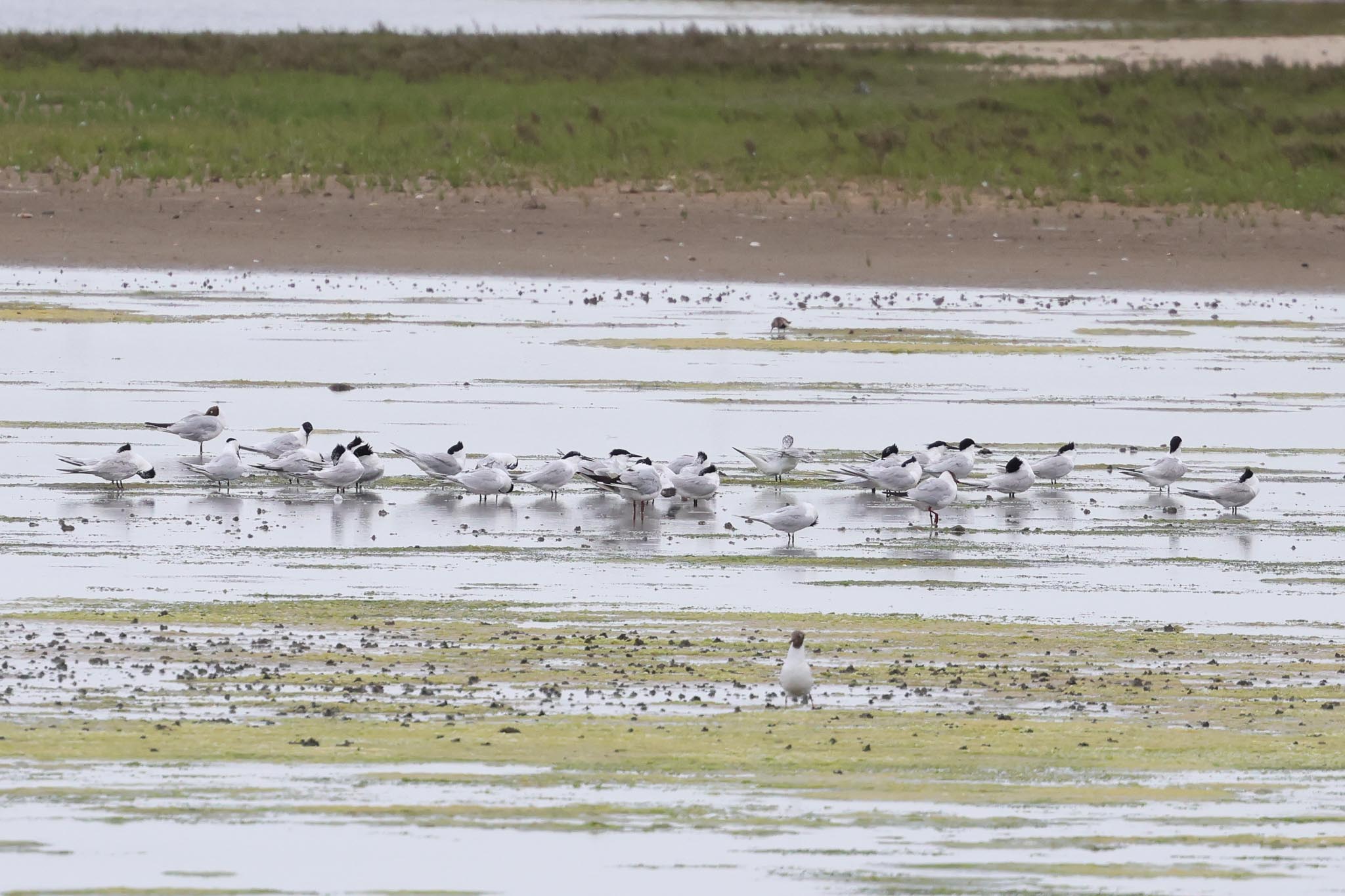
We had heard Sandwich Terns calling from the direction of Arnold’s Marsh as we walked out, and when something spooked all the terns, all the waders on Arnold’s and Pope’s took to the air too. They whirled round, but we couldn’t see what had disturbed them. One of the Ruff landed on the Serpentine, close to the bank, where we had a much better look at it. After mating with the females, the male Ruff take no part in raising the young, so they are always early to set off south. They arrived here from mid June and the first thing they do is lose their ornate ruffs, after which they look rather scruffy, with moulted heads and necks but still breeding plumage bottom halves.
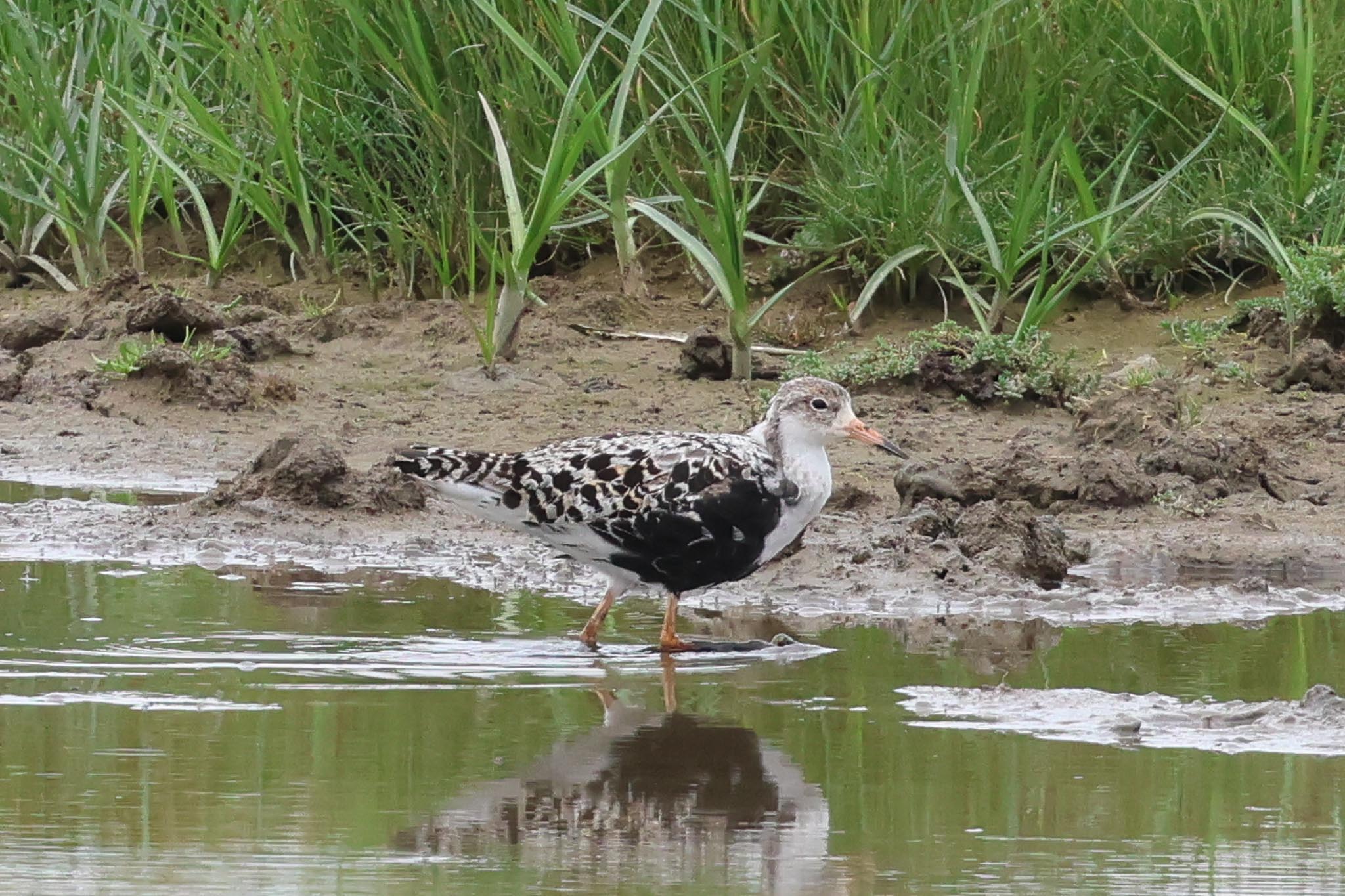
There were two freshly fledged juvenile Swallows on the fence by the main drain sluice, the adults flying in from time to time to feed them. Looking over Arnold’s from the bank just beyond, we could see all the Sandwich Terns gathered now and got them in the scope, to better see their yellow-tipped black bills. The breeding colony on Scolt Head has been badly hit with avian flu again this year, so perhaps many of these were failed breeders. There more Little Gulls were on the mud in the corner.
We pressed on to have a quick look at the sea. There was a large feeding frenzy of gulls over the sea away to the west, over towards the beach car park, a mixture of mostly Black-headed Gulls and Herring Gulls. Looking through, we did manage to pick out a couple of Mediterranean Gulls too, and a young Great Black-backed Gull. There were one or two Sandwich Terns fishing offshore and a Grey Seal surfaced just off the beach, but nothing else moving today, so we headed back for lunch. The Spoonbill was back out on the grazing marshes.
The rain was still not really getting started, thankfully much later than forecast, so were thought we could sit and have lunch on the picnic tables. It had to be a quick lunch though, as the rain started to get a little heavier, and once we had finished eating most of the group retired to the Visitor Centre for a hot drink. It was still not too wet afterwards, so we walked out to Bishop Hide to have a look at Pat’s Pool.
Someone was in the hide when we arrived, and pointed out the Long-billed Dowitcher, which was hiding in the back corner at first. We could just see it through the reeds on one of the islands. Helpfully, it started feeding after a while, coming into full view behind the island, and later working its way round the end and out onto the front edge. We could see its long bill, rather like a Snipe. It is now looking very smart, in bright rusty breeding plumage, very different from the grey winter plumage it was in through the winter.
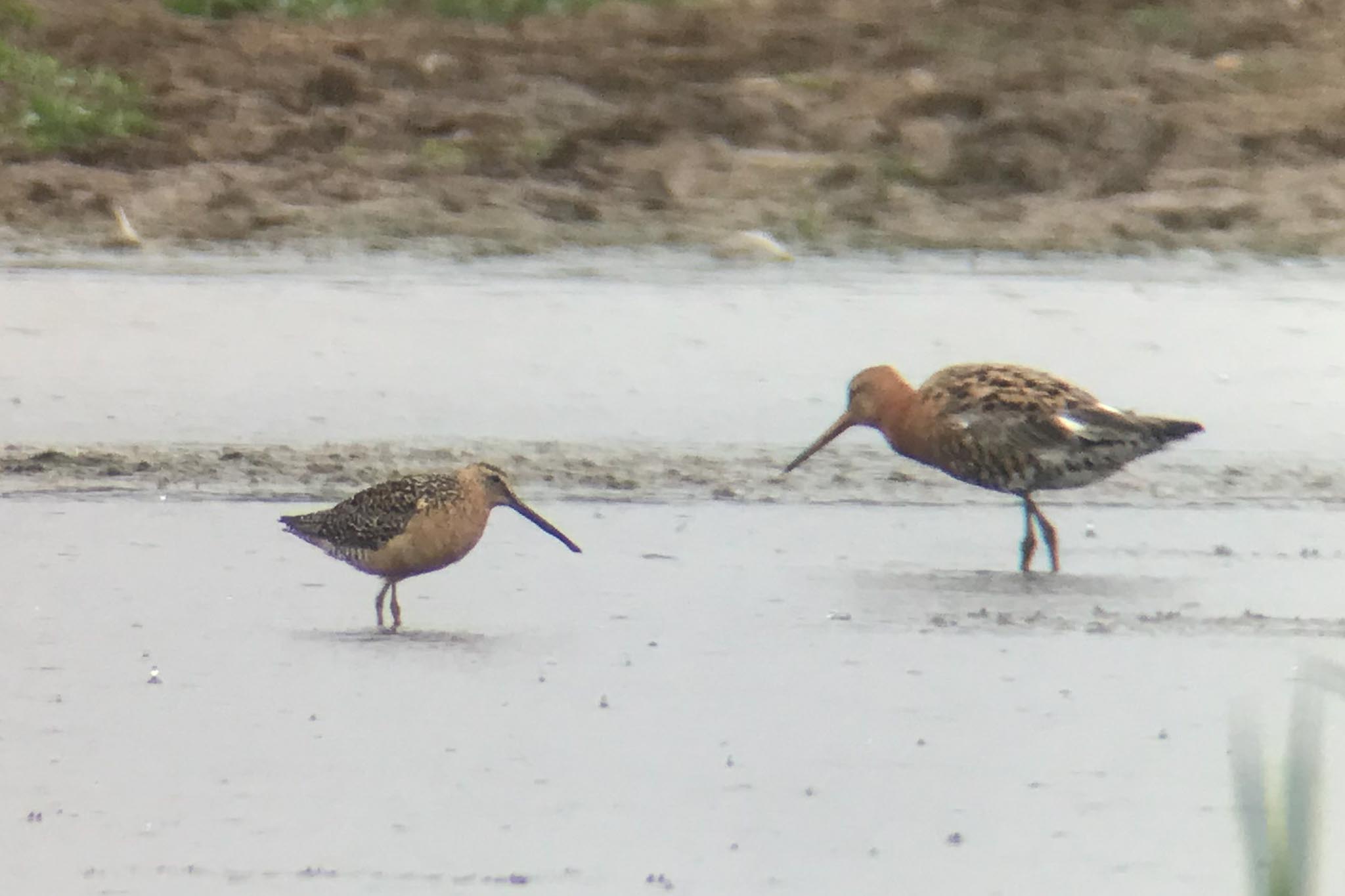
At one point, watching the Long-billed Dowitcher, a male Bearded Tit appeared on the mud at the base of the reeds behind. After a while, the flew round calling and landed with a Black-tailed Godwit. Then when the Godwit flew, the Dowitcher followed it and flew back over the reeds behind the scrape, dropping down out of view.
There were other waders on here too. As well as more Godwits, there were several more Ruff in different states of moult. When one walked across one of the islands to where a Little Ringed Plover was incubating, the plover leapt up and started its distraction display, feigning a broken wing and trying to lead the Ruff away. The Ruff was having none of it, despite at one point attracting the attention of three different Little Ringed Plovers. We could see why, when two tiny juvenile Little Ringed Plovers appeared from where the adult had first been, little more than balls of fluff on legs!
There were a couple of Ringed Plover on here too, and several more Dunlin. A Whimbrel dropped in – through the scopes, we could see its short bill and humbug striped head, different to a Curlew. An adult Spoonbill was initially asleep over in front of the central hides but woke up when a juvenile flew in and started demanding food, chasing it round and round, flapping its wings and bobbing its head up and down. The adult tried to feed it, but it was not enough and eventually flew off towards Blakeney Harbour, presumably to feed. The juvenile flew off after it at first, but then turned and landed next to another juvenile Spoonbill still on the scrape. We could see their still not fully-grown short ‘teaspoon’ bills.
We were planning to head round to the central hides to finish the day, but the rain had finally picked up, so we stayed put, waiting for a weather window when we might be able to get out there without getting too wet. There was a brief spell when it brightened up a little, but the rain never stopped. We contented ourselves with watching the birds on Pat’s Pool. Apart from a Caspian Gull and a Kittiwake, it didn’t sound like there was much we were missing, so eventually we decided to call it a day and head for home. Better to stay as dry as we can today, on our first day!
















